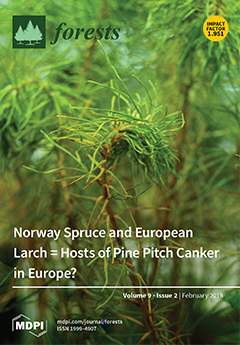Cross Timbers forests, typically dominated by
Quercus stellata Wangenh. and
Q. marilandica Muenchh., are the transition zone between eastern deciduous forest and prairie in the southern Great Plains. Fire exclusion beginning in the mid-1900s has led to increasing stand density and encroachment of
[...] Read more.
Cross Timbers forests, typically dominated by
Quercus stellata Wangenh. and
Q. marilandica Muenchh., are the transition zone between eastern deciduous forest and prairie in the southern Great Plains. Fire exclusion beginning in the mid-1900s has led to increasing stand density and encroachment of fire-intolerant
Juniperus virginiana L. and mesic hardwood. We measured current forest structure and tree ages of 25 stands (130 plots) in north-central Oklahoma to characterize the extent and dynamics of encroachment. The respective basal area and stand density of the overstory (diameter at breast height; dbh > 10 cm) were 19.0 m
2 ha
−1 and 407 trees ha
−1 with
Q. stellata comprising 43% of basal area and 42% of stand density.
Quercus marilandica represented only 3% of basal area and 4% of overstory density.
Juniperus virginiana represented 7% of basal area and 14% of stand density while mesic hardwoods, e.g.,
Celtis spp.,
Ulmus spp.,
Carya spp., 33% of basal area and stand density. The sapling layer was dominated by mesic hardwoods (68%) and
J. virginiana (25%) while the seedling layer was dominated by mesic hardwoods (74%). The majority of
Quercus recruited into the overstory between 1910–1970, while recruitment of
J. virginiana and mesic hardwoods began more recently (post 1950s). Growth rate, based on the relationship between age and dbh, was faster for mesic hardwoods than for
J. virginiana and
Q. stellata. These results indicate that removal of recurrent surface fire as a disturbance agent has significantly altered forest composition in the Cross Timbers region by allowing encroachment of
J. virginiana and fire-intolerant, mesic hardwoods. This increases wildfire risk because
J. virginiana is very flammable and will alter how these forests respond to future drought and other disturbance events.
Full article





